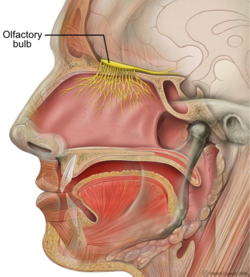Olfactory bulbs
| Olfactory bulb | |
|---|---|

Human brain seen from below. Vesalius' Fabrica, 1543. Olfactory bulbs and olfactory tracts outlined in red
|
|

Sagittal section of human head.
|
|
| Details | |
| System | Olfactory |
| Identifiers | |
| Latin | bulbus olfactorius |
| MeSH | A08.186.211.577.699.573 |
| NeuroNames | hier-261 |
| NeuroLex ID | Olfactory bulb |
| Dorlands /Elsevier |
b_26/12200284 |
| TA | A14.1.09.429 |
| FMA | 77624 |
|
Anatomical terms of neuroanatomy
[]
|
|
The olfactory bulb (bulbus olfactorius) is a neural structure of the vertebrate forebrain involved in olfaction, the sense of smell.
In most vertebrates, the olfactory bulb is the most rostral (forward) part of the brain, as seen in rats. In humans, however, the olfactory bulb is on the inferior (bottom) side of the brain. The olfactory bulb is supported and protected by the cribriform plate of the ethmoid bone, which in mammals separates it from the olfactory epithelium, and which is perforated by olfactory nerve axons. The bulb is divided into two distinct structures: the main olfactory bulb and the accessory olfactory bulb.
The main olfactory bulb has a multi-layered cellular architecture. In order from surface to the center the layers are:
The olfactory bulb transmits smell information from the nose to the brain, and is thus necessary for a proper sense of smell. As a neural circuit, the glomerular layer receives direct input from afferent nerves, made up of the axons from approximately ten million olfactory receptor neurons in the olfactory mucosa, a region of the nasal cavity. The ends of the axons cluster in spherical structures known as glomeruli such that each glomerulus receives input primarily from olfactory receptor neurons that express the same olfactory receptor.The glomeruli layer of the olfactory bulb is the first level of synaptic processing. The glomeruli layer represents a spatial odor map organized by chemical structure of odorants like functional group and carbon chain length. This spatial map is divided into zones and clusters, which represent similar glomeruli and therefore similar odors. One cluster in particular is associated with rank, spoiled smells which are represented by certain chemical characteristics. This classification may be evolutionary to help identify food that is no longer good to eat.
...
Wikipedia
